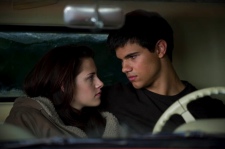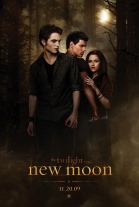The Twilight Saga: New Moon
|  Twilight, Catherine Hardwicke’s moody, stylized adaptation of the first entry in Stephanie Meyer’s four-book series, didn’t do much for me. Of course, I also recognize that, since I am not a 13-year-old girl, it wasn’t made with me in mind, and I will admit that, while there were parts that bordered on the insufferable, I could see appeal and even concede that parts of it work with a rare sense of naked romanticism. For the adaptation of the second book, New Moon, which arrives in theaters on a wave of baited anticipation bordering on the hysterical, Hardwicke has been replaced by Chris Weitz (The Golden Compass), and if his is a slightly better film, it is largely because he is working with a more involved story and wisely dials down the stylization to something a little less overwhelming. The film also benefits from greater romantic tension emanating from a love triangle, the inclusion of werewolves, and Kristen Stewart reducing her lower lip biting by at least fifty percent. Twilight, Catherine Hardwicke’s moody, stylized adaptation of the first entry in Stephanie Meyer’s four-book series, didn’t do much for me. Of course, I also recognize that, since I am not a 13-year-old girl, it wasn’t made with me in mind, and I will admit that, while there were parts that bordered on the insufferable, I could see appeal and even concede that parts of it work with a rare sense of naked romanticism. For the adaptation of the second book, New Moon, which arrives in theaters on a wave of baited anticipation bordering on the hysterical, Hardwicke has been replaced by Chris Weitz (The Golden Compass), and if his is a slightly better film, it is largely because he is working with a more involved story and wisely dials down the stylization to something a little less overwhelming. The film also benefits from greater romantic tension emanating from a love triangle, the inclusion of werewolves, and Kristen Stewart reducing her lower lip biting by at least fifty percent.The story in New Moon picks up where Twilight left off, with teenage Bella (Stewart) in love with Edward Cullen (Robert Pattison), a 109-year-old vampire who looks like a lusty high school senior (at the beginning of the film she turns 18, thus ensuring that the unspoken cradle-robbing is at least now technically legal). Alas, the complications of human-vampire love prove to be too much, and Edward leaves her, ostensibly for her own safety (although Edward and his family are “vegetarian” vampires, meaning they don’t feed on humans, they can’t always guarantee Bella’s safety around others of their kind). This leaves Bella alone in the remote town of Forks, Washington, with her well-meaning but emotionally clueless single father (Billy Burke) and a lot of ensuing loneliness, depression, and moping, which is eventually alleviated by the presence of Jacob Black (Taylor Lautner), a 16-year-old Native American who has carried a torch for Bella since childhood and has recently filled out into full-scale hunkdom, which he proves by spending pretty much the entire second half of the film sans shirt. Thus develops the love triangle, with Bella caught between her longing for the absent Edward (who appears in ghostly form whenever she is in danger, which of course inspires her to take constant risks) and the ever-present Jacob, whose brooding, furrowed-brow intensity just isn’t quite enough to fully light Bella’s fire as long as she has Edward on the mind. As was hinted at in the first film, Jacob is guarding his own supernatural secret, namely that he is part of a special group within his tribe that turns into werewolves and is engaged in a longstanding war with vampires (although they have a tenuous pact with the Cullens as long as they stay away from human necks). From a metaphorical perspective, Bella is in every adolescent girl’s dream position, trapped between a beautiful, pale-skinned vampire who is elegant and haunting and a beautiful, dark-skinned werewolf with great abs who is good with his hands. Alas, as it plays out literally, it’s not always such a great place to be, especially when the competing boyfriends are getting ready to tear each other apart. Recovering from the mega-disaster that was The Golden Compass (2007), Weitz manages to sustain the film’s momentum despite a complete lack of humor (aside from Michael Sheen bringing some much needed camp to his portrayal of the leader of the Volturi, the Italy-based vampire governing council) and an overlong running time that both benefits and suffers from Edward’s lengthy absence. By the time he finally re-enters the narrative, he has been gone long enough that it’s easy to wish Bella into Jacob’s arms, thus depriving the film’s climactic reunion some of its romantic heat (when you start wondering what Bella sees in Edward, we have problems). The film also plays gingerly with some long-standing conventions, particularly the werewolf transformation, which is usually drawn out into a showpiece of special effect wizardry but is here presented as a blink-and-you-miss conversion from the human to the lupine. Despite a much larger budget than Twilight, the digital effects are rarely better than passable, with the wolves frequently looking hokey and cartoonish (this is especially the case when Weitz goes for the extreme close-up of the wolf’s eye, which always has Bella symbolically reflected in it). Digital wizardry aside, New Moon’s real special effect is its air of swooning romanticism, which continues to find buoyancy in thwarted love and delayed passion and, most importantly, leaves its legions of devoted fans panting for more. Copyright ©2009 James Kendrick Thoughts? E-mail James Kendrick All images copyright © Summit Entertainment |
Overall Rating: 

 (2.5)
(2.5)


